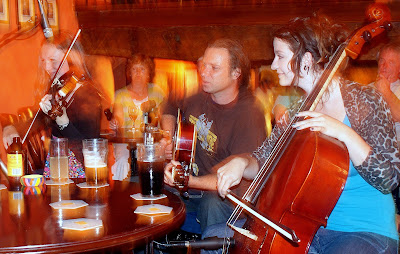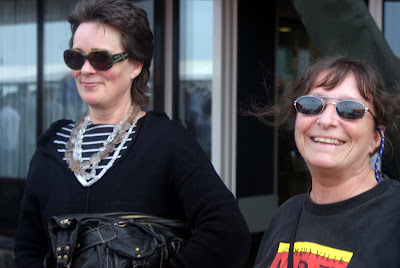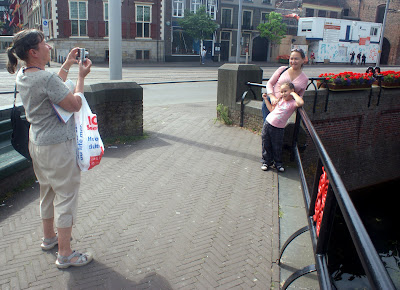Dinner with Laurie and Sue was lovely. John says both times he has had home-cooked moules, they were significantly better than the ones he had at the restaurant in Dieppe. After dinner we watched NCIS, which was fun. Laurie and Sue didn’t have television last year when we were there. They seem to enjoy some of the same American shows that my family and I do.
We stayed an extra day in Cherbourg to take care of some boat chores. The staysail halyard was chafing in the middle, and the deck light and steaming light (the same fixture) was out. John had to go up the mast to fix the light, and several people walking down the dock talked to him. They seemed impressed with his mast-climbing equipment. It turns out that a screw on the deck light fixture had a protruding sharp edge that was damaging the staysail halyard. John smoothed it out and covered it while he was up there. Then he reversed the halyard so that the chafed part isn’t under tension when the sail is up.
Sunday we set off for Alderney. There was wind off and on, so we sailed when we could. At one point we were doing more than nine knots, but there really wasn’t any wind. It was all current!
In Alderney we decided to anchor rather than pick up a mooring buoy. According to Reed’s if you fly your quarantine flag (a plain yellow signal flag that stands for Q), the harbormaster comes to you with the customs forms and other paperwork. Although we arrived in mid-afternoon, no one came by the boat, so in the morning we put the dinghy in the water and went to the harbormaster. He called Customs, and we took care of all of the formalities in one stop. Märzen couldn’t go ashore, but we know she doesn’t mind about that.
Alderney is a rocky island, and the town of St. Anne is pretty with lots of stone houses. We had lunch and a beer, but didn’t visit the museum. As in France most businesses close for an hour or two at lunchtime, which was when we were in town, of course, so that kept us from the temptation of buying anything. John could really use a few new t-shirts to replace ones that have been ruined by boat chores, but he’ll have to get them somewhere else.
When we got back to the boat, the young harbormaster’s assistant stopped by to see if we wanted to pay him. Of course, we paid at the office, so there was nothing for him to do. In the morning he stopped by again. This time it was with a printout of the weather forecast, which was much appreciated, and we took the opportunity to confirm the time that we should leave for Guernsey. The tidal streams (or currents) in the Channel Islands are fierce, and you really have to go with the flow.
Some weather in the Atlantic is really affecting the sea state in the Channel, and it was a decidedly bumpy ride to Guernsey this afternoon. We also had 20-knot wind on our nose most of the way, so it wasn’t a quick trip, even with favorable current. The current only really kicked in once we got in the wind and wave shadow of the island.
St. Peter Port, where we are, has a fairly large harbor filled with boats. We’re rafted on a pontoon that isn’t connected to the shore because of Märzen. The neighbors are a French boat, and they also have a dog. They’ve been very friendly and curious about us, and they even gave us a bottle of wine! (I’d said that we like French wine.) They’ll be leaving at six o’clock tomorrow morning, and then we’ll get to be the inside boat. The pontoons don’t have electricity, but they do have fresh water. And there’s free wireless Internet, which John rowed ashore to arrange after dinner tonight.
 Another map. Our proposed next stop is Tréguier
Another map. Our proposed next stop is Tréguier
It’s the next day now. I didn’t get this posted last night, but we were up early to let the French boat off the dock. Either they hadn’t been in a raft-up before, or they didn’t understand that we were staying. In any case, we drifted in the crowded harbor on a fairly windy morning while they watched us, looking puzzled. Finally, I indicated that we wanted to go back to the dock after they left. They got the message, but by then we had found another open spot and took it. High winds are expected to blow through here today, and our other spot would have been a little less exposed, but we’re securely tied and heavily fendered now, so we’re good. (We’re also closer to the wireless Internet antenna, and that’s a plus, especially since we don't much feel like going ashore in this weather.)
 Channel markers at the approach
Channel markers at the approach View of artichoke fields from the river
View of artichoke fields from the river Typical stone houses with flower boxes
Typical stone houses with flower boxes Our night lights: buoys off the stern
Our night lights: buoys off the stern

























